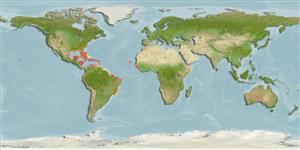Asteroidea |
Valvatida |
Oreasteridae
Environment: milieu / climate zone / depth range / distribution range
Ecology
Benthic; depth range 0 - 69 m (Ref. 111335). Tropical
Atlantic Ocean: USA through the Caribbean to Brazil, Cape Verde to western Africa.
Length at first maturity / Size / Weight / Age
Maturity: Lm ? range ? - ? cm
Inhabits Thalassia sp. beds and mangrove channels (Ref. 415, 87194). Known as a potential corallivore that particularly feeds on Agaricia tenuifolia (Ref. 86570).
Life cycle and mating behavior
Maturity | Reproduction | Spawning | Eggs | Fecundity | Larvae
Members of the class Asteroidea exhibit both asexual (regeneration and clonal) and sexual (gonochoric) means of reproduction. Life cycle: Embryos hatch into planktonic larvae and later metamorphose into pentamorous juveniles which develop into young sea stars with stubby arms.
Collin, R., M.C. Díaz, J. Norenburg, R.M. Rocha, J.A. Sánchez, M. Schulze, A. Schwartz and A. Valdés 2005 Photographic identification guide to some common marine invertebrates of Bocas Del Toro, Panama. Caribbean Journal of Science. 41(3):638-707. (Ref. 415)
IUCN Red List Status
(Ref. 130435: Version 2025-1)
CITES status (Ref. 108899)
Not Evaluated
Not Evaluated
Threat to humans
Human uses
| FishSource |
Tools
More information
Population dynamicsGrowth
Max. ages / sizes
Length-weight rel.
Length-length rel.
Length-frequencies
Mass conversion
Abundance
Life cycleReproductionMaturityFecunditySpawningEggsEgg developmentLarvae PhysiologyOxygen consumption
Human RelatedStamps, coins, misc.
Internet sources
Estimates based on models
Preferred temperature
(Ref.
115969): 25.4 - 28, mean 27.3 (based on 204 cells).
Price category
Unknown.
